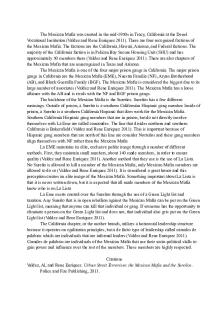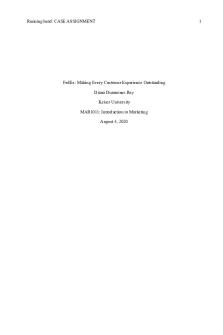Week 1 Learning Style assignment post PDF

| Title | Week 1 Learning Style assignment post |
|---|---|
| Author | Tammy Graham |
| Course | Psychology |
| Institution | Keiser University |
| Pages | 6 |
| File Size | 149.6 KB |
| File Type | |
| Total Downloads | 73 |
| Total Views | 153 |
Summary
Learning style assignment and assessment of how we learn best and techniques to apply to study habits....
Description
1
Learning Style Assessment
Tammy Graham
Department of Psychology, Keiser University
Course Code: PSY1012G3-1: Introduction to Psychology
Dr. Wellman
July 11, 2021
2
The Results The ILS (Individual Learning Style) assessment results show the type of learning style best suited for how I learn.
The results show a strong motivation by visual learning, a moderate preference for active and sensing learning, and reasonably well balanced in the dimension of sequential and global understanding. What does all this mean, aside from the obvious, clearly shows a preference for visually learning. For example, in Algebra and Introduction to Computers, Pearson Mathlab has sequential steps, show me, guide me, and let me try, effective for learning new material.
3
How I Learn Best
According to Barbra Soloman, coordinator of Advising, First Year College, North Carolina State University, Factors determine a student's learning style in the four dimensions of Models of Learning & Teaching Styles. They are learning how students take in information, sensory experience, or intuitive thought. Teaching style refers to delivering information (concrete, abstract-conceptual, theoretical) and mode of information (visual-verbal). (Felder & Soloman, 1993)
What do the results mean?
Results show a preference for Active-Reflective with a preference moderately more on the active side, discussion, and explaining information. For instance, working in a group, a good assessment. A preference more on the active side as opposed to the reflective side, a good assessment. Then is Sensing-Intuitive, which has a more apparent preference towards the sensing side, for example, learning facts and details, memorizing things, practical and careful (still practicing the careful part). The next dimension, Visual-Verbal, visual seen, such as pictures charts and demonstrations, shows a strong preference, excellent assessment in this category. Having such a strong preference means if the teaching method does not include talking about or illustrations, it could hurt overall learning and experience. Finally, Sequential-Global, in order rather than in large jumps, understands linear steps that logically fall in order from the previous step. This dimension shows an equal preference for one or the other. A good assessment, having
4 steps to follow in order or not seeing the connections and suddenly "getting it," is an excellent assessment. (Felder & Silverman, 1988)
How do I Learn Best
Learning has been a constant challenge throughout my academic career, and since returning to school, the same pattern has continued. Not understanding how information is processed or delivered contributed to the problem. As a result, my learning style (before I knew it) scattered, reading all the material ingesting it until becoming overstuffed, overwhelmed, frazzled, frustrated, and more often than not, totally lost. Then the feeling of dread, insecurity, and much self-doubt, leading to working on one assignment for two days (as I did last week). There is still a lot of trial and error, but it is essential to keep trying to progress.
Understanding personal learning style is beneficial. As an active, visual, sensing, and sequential learner, and a strong preference for videos over lectures. Interacting by actively participating in discussions and explanations; doing this makes the connection between the information and using the information to do something with the information. For instance, in MathLab, the feature Show me, Guide me, Let me try a tool that helped me understand my learning style. In addition, having a physical disability and learning how to adapt to tasks has given some insight into visual learning. So, relating to the Show me, Guide me, Let me try, felt familiar with the way I currently approach daily life. The results also show a preference for sensing over reflective; in agreement with that, learning facts and new information is intriguing. Although learning new information is challenging at times, sometimes it is hard to make the connection. Often I cannot see the forest through the trees. Lastly, there were prior hints in this
5 category; like building a recipe, there is a solid personal preference. Having a list and step-bystep instructions have helped complete tasks in the past and continue to do so now.
Modification of Study Techniques
I will modify my study habits with the information learned in the assessment to break down the material into manageable bites— seek out visual and sensory resources within the course and actively participate in discussions and explanations in groups. Making connections between the course material and the understanding (which frequently are not obvious) is essential to ensure the meaning behind the knowledge. The results also show an equal preference for sequential-global learning suggests studying in an organized, orderly manner. Such as creating an outline for the material that follows a logical order— logically going from one step to the next. I did not know before starting this process because a global learner often thinks of themselves as slow, or stupid and learning that was not the case. Instead of learning that is false, global learners learn differently than others. (Felder & Soloman, 1993) The last tool added to the toolbox is understanding that learning style is unique to the person, and it is not a personal reflection of ability.
References
6
Felder, R. (n.d.). Learning styles and index of learning styles. NC State University. https://www.engr.ncsu.edu/stem-resources/legacy-site/learning-styles/
Felder, R. M., & Silverman, L. K. (1988). Learning and teaching styles in engineering education. Institute for the Study of Advanced Development, Engr. Education, 78(7), 674–681
Felder, R, M., & Soloman, B. A. (1993). Learning styles and strategies.https://www.engr.edu/wpcontent/uploads/drive/1WPAfj3j5o50u[Hor]:
WC=890...
Similar Free PDFs

Week 1 Discussion Post
- 1 Pages

Informatics week 1 post
- 2 Pages

Week 1 Forum Post
- 11 Pages

Learning Style Comparison
- 6 Pages

Week 1 - week 1 discussion post
- 4 Pages

Learning Style Questionnaire
- 3 Pages

Week 1 Learning Journal
- 2 Pages

Week 2 Post - Week 2 Post
- 1 Pages

Week 1 Case Assignment
- 4 Pages

Week 1, Assignment
- 8 Pages

Week 1 Homework Assignment
- 1 Pages
Popular Institutions
- Tinajero National High School - Annex
- Politeknik Caltex Riau
- Yokohama City University
- SGT University
- University of Al-Qadisiyah
- Divine Word College of Vigan
- Techniek College Rotterdam
- Universidade de Santiago
- Universiti Teknologi MARA Cawangan Johor Kampus Pasir Gudang
- Poltekkes Kemenkes Yogyakarta
- Baguio City National High School
- Colegio san marcos
- preparatoria uno
- Centro de Bachillerato Tecnológico Industrial y de Servicios No. 107
- Dalian Maritime University
- Quang Trung Secondary School
- Colegio Tecnológico en Informática
- Corporación Regional de Educación Superior
- Grupo CEDVA
- Dar Al Uloom University
- Centro de Estudios Preuniversitarios de la Universidad Nacional de Ingeniería
- 上智大学
- Aakash International School, Nuna Majara
- San Felipe Neri Catholic School
- Kang Chiao International School - New Taipei City
- Misamis Occidental National High School
- Institución Educativa Escuela Normal Juan Ladrilleros
- Kolehiyo ng Pantukan
- Batanes State College
- Instituto Continental
- Sekolah Menengah Kejuruan Kesehatan Kaltara (Tarakan)
- Colegio de La Inmaculada Concepcion - Cebu




